Aquarium Conditioned
Longnose Hawkfish
Oxycirrhites typus
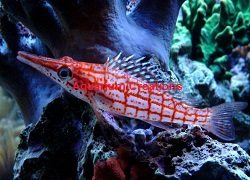
You Tube Video of the Longnose Hawkfish
Description:
Known as the Longnose Hawkfish, Long-Nose Hawkfish or Longnose Hawk. They have a very distinct needle-like snout that looks narrow, but is actually quite voluminous. Because of this, theLongnose Hawkfish is quite capable of eating ornamental invertebrates. Quite easy to care for, the Longnose Hawkfish is also one of the least aggressive of the Hawkfish. The Longnose Hawkfish is a hardy, semi-aggressive fish. Although it eats small fish and shrimp, it makes an excellent reef inhabitant under the proper conditions. It likes to perch on and be camouflaged by the Red Gorgonian Sea Fan or other similar decor.
Tank Recommendations:
A 30 gallon or larger aquarium is acceptable, and should have a tight-fitting lid to prevent escape. Although it eats small fish and shrimp, with caution, it can make an excellent reef inhabitant. The aquarium requires live rock on which the hawkfish can perch itself on, just like it would in the wild. Keeping more than one hawkfish (unless it is a compatible pair) will require a really big and cleverly decorated aquarium. The hawkfish is normally kept in an aquarium with fish from other families. As a general rule, it is best to add all the other fish to the aquarium and let them familiarize themselves with the environment before introducing your hawkfish.
Food and diet:
Hawkfish are a predatory species that needs a carnivore diet in the aquarium. The best diet for Hawkfish will be composed of meats, frozen foods and live feeder shrimp. While it is possible, it is not common for Longnose Hawkfish to eat any form of prepared food. As with most marine fish, feed the hawkfish twice a day.
Level of Care:
Easy
Acclimaton Time:
2+ hours
Reef Compatibility
:with caution
Approximate Purchase Size:
Small 1-1/4" to 2" Medium 2" to 2-1/2" Large 2-1/2" to 3"
|
Small $47.99
Medium $49.99
Large $59.99
|
|
Aquarium Conditioned
Falco Hawkfish
Cirrhitichthys falco
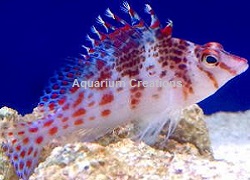
You Tube Video of the Falco Hawkfish
Description:
One of the most spectacular, and most divergent, of the hogfish species is Bodianus anthioides. It is easily recognized by its deeply incised to emarginate tail and its general form. In some ways it looks more like an anthias than a wrasse, hence its species name anthioides. An Orange, Red, and White fish with a long flowing tail, the Lyretail Hogfish has distinct patterns that have minor changes with maturity. This is a moderately aggressive fish that should only be housed with tankmates of similar temperament such as some Butterflyfish, Hawkfish, Rabbitfish, and Anthias. Adults may display temporary, and possibly permanent sexual dichromatism and appear to be sexually dimorphic, with males attaining larger sizes than females.
Tank Recommendations:
A 30 gallon or larger aquarium is acceptable, and should have a tight-fitting lid to prevent escape. Although it eats small fish and shrimp, with caution, it can make an excellent reef inhabitant. The aquarium requires live rock on which the hawkfish can perch itself on, just like it would in the wild. Keeping more than one hawkfish (unless it is a compatible pair) will require a really big and cleverly decorated aquarium. The hawkfish is normally kept in an aquarium with fish from other families. As a general rule, it is best to add all the other fish to the aquarium and let them familiarize themselves with the environment before introducing your hawkfish.
Food and diet:
Hawkfish are a predatory species that needs a carnivore diet in the aquarium. The best diet for Hawkfish will be composed of meats, frozen foods and live feeder shrimp. While it is possible, it is not common for Longnose Hawkfish to eat any form of prepared food. As with most marine fish, feed the hawkfish twice a day.
Level of Care:
Easy
Acclimaton Time:
2+ hours
Reef Compatibility
Yes with caution
Approximate Purchase Size:
Small: 3/4" to 1-1/4" Medium: 1-1/4" to 2" Large 2" to 3"
|
Small $43.99
Medium $47.99
Large $54.99
|
Aquarium Conditioned
Flame Hawkfish
Bodianus mesothorax
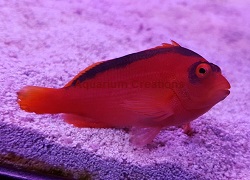
Click to view You Tube Video Flame Hawkfish
Description:
The most popular of all Hawkfish. The Flamehawk is bright red with black mascara around the eye and a black line along the back. This species will pearch in a favorite spot, occasionally roaming up to a few spots in the tank. They adapt well to aquarium life and generally learn to accept food quickly. This species is one of the least aggressive Hawkfishes, but may be aggressive toward smaller, passive fishes. Provide with structures to perch on and nooks and crannies to hide in (in nature it lives within branching coral heads).
Tank Recommendations:
A 30 gallon or larger aquarium is acceptable, and should have a tight-fitting lid to prevent escape. Although it eats small fish and shrimp, with caution, it can make an excellent reef inhabitant. The aquarium requires live rock on which the hawkfish can perch itself on, just like it would in the wild. Keeping more than one hawkfish (unless it is a compatible pair) will require a really big and cleverly decorated aquarium. The hawkfish is normally kept in an aquarium with fish from other families. As a general rule, it is best to add all the other fish to the aquarium and let them familiarize themselves with the environment before introducing your hawkfish.
Food and diet:
Hawkfish are a predatory species that needs a carnivore diet in the aquarium. The best diet for Hawkfish will be composed of meats, frozen foods and live feeder shrimp. While it is possible, it is not common for Longnose Hawkfish to eat any form of prepared food. As with most marine fish, feed the hawkfish twice a day.
Level of Care:
Easy
Acclimaton Time:
2+ hours
Reef Compatibility
Yes with caution
Approximate Purchase Size:
Small: 3/4" to 1-1/2"; Medium: 1-1/2" to 2-1/2"; Large: 2-1/2" to 3-1/2"
|
Small $69.99
Medium $74.99
Large $84.99
|
|
|
Aquarium Conditioned
Arc Eye Hawkfish
Bodianus sepiacaudus
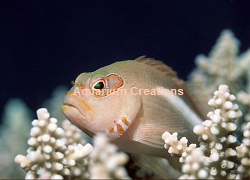
Click to view You Tube Video Arc Eye Hawkfish
Description:
The arc-eye hawkfish (Paracirrhites arcatus) is a species of hawkfish belonging to the genus Paracirrhites. It is found in shallow waters in the tropical IndoPacific on reefs, resting on coral heads much of the time. The Arc Eye Hawkfish, also referred to as the Arc-Eyed Hawkfish, has an orange body with a white horizontal bar on the back half. They have a distinctive arc behind the eye with an alternating blue and bright orange pattern. If looked at closely, the arc consists of three thin lines. The Arc Eye Hawkfish can become very territorial, and will harass new additions to the tank including other hawkfish and larger fish.
Tank Recommendations:
A 30 gallon or larger aquarium is acceptable, and should have a tight-fitting lid to prevent escape. Although it eats small fish and shrimp, with caution, it can make an excellent reef inhabitant. The aquarium requires live rock on which the hawkfish can perch itself on, just like it would in the wild. Keeping more than one hawkfish (unless it is a compatible pair) will require a really big and cleverly decorated aquarium. The hawkfish is normally kept in an aquarium with fish from other families. As a general rule, it is best to add all the other fish to the aquarium and let them familiarize themselves with the environment before introducing your hawkfish.
Food and diet:
Hawkfish are a predatory species that needs a carnivore diet in the aquarium. The best diet for Hawkfish will be composed of meats, frozen foods and live feeder shrimp. While it is possible, it is not common for Longnose Hawkfish to eat any form of prepared food. As with most marine fish, feed the hawkfish twice a day.
Level of Care:
Easy
Acclimaton Time:
2+ hours
Reef Compatibility
Yes with caution
Approximate Purchase Size:
Small: 1" to 2"; Medium: 2" to 3"; Large: 3" to 5"
|
Small$54.99
Medium $59.99
Large $69.99
|
Aquarium Conditioned
Freckled Hawkfish
Paracirrhites forsteri
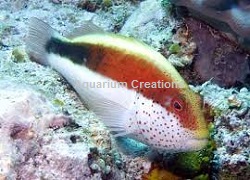
Description:
Usually found in the coral reefs of both the western and eastern Atlantic and Indo-Pacific. Also called the Black Side Hawkfish, it is a species of hawkfish found extensively in Southern Hawai'i and central Polynesia, Micronesia, Melanesia and across the Indian Ocean to the coast of Africa and the Red Sea. It is occasionally found in the aquarium trade. It has Red-brown spots on head and operculum, highly variable body pattern and colouration but generally includes pale strip below dorsal fin. Perches among branching corals. In the wild, the Freckled Hawkfish generally attains a size of around 9" as a full adult.
Tank Recommendations:
Being a fairly large species the minimum tank size would be a 75 gallon or larger aquarium, and should have a tight-fitting lid to prevent escape. Although it eats small fish and shrimp, with caution, it can make an excellent reef inhabitant. The aquarium requires live rock on which the hawkfish can perch itself on, just like it would in the wild. Keeping more than one hawkfish (unless it is a compatible pair) will require a really big and cleverly decorated aquarium. The hawkfish is normally kept in an aquarium with fish from other families. As a general rule, it is best to add all the other fish to the aquarium and let them familiarize themselves with the environment before introducing your hawkfish.
Food and diet:
Hawkfish are a predatory species that needs a carnivore diet in the aquarium. The best diet for Hawkfish will be composed of meats, frozen foods and live feeder shrimp. While it is possible, it is not common for Longnose Hawkfish to eat any form of prepared food. As with most marine fish, feed the hawkfish twice a day.
Level of Care:
Easy
Acclimaton Time:
2+ hours
Reef Compatibility
Yes with caution
Approximate Purchase Size:
Small: 1" to 2"; Medium: 2" to 3"; Large: 3" to 5"
|
Small$54.99
Medium $59.99
Large $69.99
|
Aquarium Conditioned
Coral Hawkfish
Cirrhitichthys oxycephalus
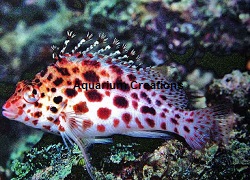
Description:
If you like smaller more hawkfish, the Coral Hawkfish is one of the smaller and more desirable species since it is less of a threat to its tankmates. The Coral Hawkfish, also called the Pixie Hawkfish or Spotted Hawkfish, is one of the most popular Hawkfish for the home saltwater aquarium. This species has spots that form bars on the side of the body and lines on the underside of the head. They have very intricate and colorful markings. Although hard to see in the photo, they have bright yellow tufts (typical of hawkfish) on the dorsal fin rays. Hawkfish are among the easiest to keep saltwater aquarium fish and the Coral Hawkfish are very easy to keep.
Food and diet:
Hawkfish are a predatory species that needs a carnivore diet in the aquarium. The best diet for Hawkfish will be composed of meats, frozen foods and live feeder shrimp. While it is possible, it is not common for Longnose Hawkfish to eat any form of prepared food. As with most marine fish, feed the hawkfish twice a day.
Level of Care:
Easy
Acclimaton Time:
2+ hours
Reef Compatibility
Yes with caution
Approximate Purchase Size:
1-1/4" to 2-1/2"
|
|
| |
Aquarium Conditioned
Geometric Pygmy Perchlet
Plectranthias Inermis
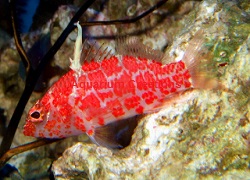
Click to view You Tube Video Geometric Pygmy Perchlet
Description:
The Geometric Pygmy Perchlet also called the Hi Fin Perchlet went from unknown to the trade to mega popular in record time. Discovered in the rubble beds of Cebu and often found among plate corals (fungia sp.), Scientists say though the Geometric although looking like a Hawkfish species, are definitely NOT. They are actually in the Anthiinae subfamily like many other popular Anthias . The perfect Nano reef aquarium fish, it attains a maximum length of only about 2 inches, and its very easy to care for. It is a threat to small ornamental shrimp (e.g., anemone shrimp), but otherwise, your prized invertebrates will be safe in the perchlet tank. It is also a threat to small gobies (e.g., Eviota, Trimma, Trimmatom). As far as its piscine neighbors are concerned, P. inermis is best housed with small, passive fish species (smaller cardinalfishes, small wrasses, blennies, dragonets, gobies, dartfishes). Its diminutive stature also means it a potential meal for large fish-eaters and a target of benthic bullies (e.g., dottybacks, hawkfishes).
Tank Recommendations:
The Geometric Pygmy Perchlet lives along the reefs in the wild, particular to the rubble zones. Rather than soaring about, high in the water column, they spend their time in repose on the seafloor. We recommend an aquarium of at least 30 gallons with plenty of live rock for hiding and feeding.
Food and diet:
The Geometric Pygmy Perchlet's natural diet includes zooplankton, and they should be offered a variety of meaty foods including; vitamin enriched brine shrimp, mysis shrimp and small pieces of shrimp and fish.
Level of Care:
Easy
Acclimaton Time:
2+ hours
Reef Compatibility
Yes with caution
Approximate Purchase Size:
1" to 1-3/4"
|
|
|
|
Copyright 2020 Aquarium Creations Online
Photos are representative of each species. All marine life will be unique and variations should be expected, color and sizes may vary.
|







